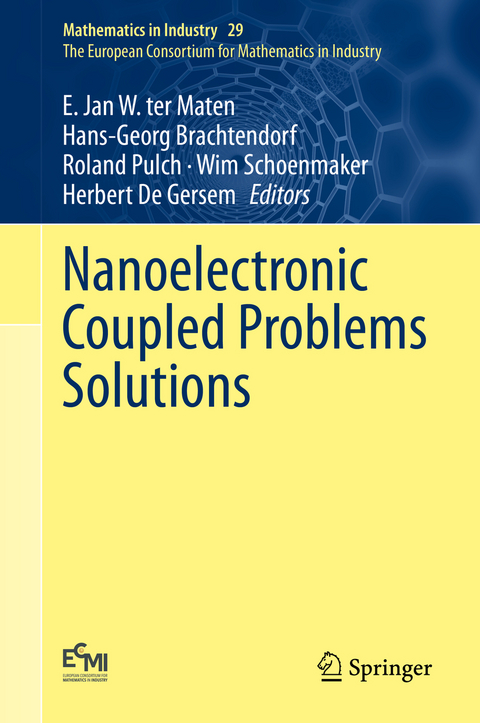
Nanoelectronic Coupled Problems Solutions
Springer International Publishing (Verlag)
978-3-030-30725-7 (ISBN)
Designs in nanoelectronics often lead to challenging simulation problems and include strong feedback couplings. Industry demands provisions for variability in order to guarantee quality and yield. It also requires the incorporation of higher abstraction levels to allow for system simulation in order to shorten the design cycles, while at the same time preserving accuracy. The methods developed here promote a methodology for circuit-and-system-level modelling and simulation based on best practice rules, which are used to deal with coupled electromagnetic field-circuit-heat problems, as well as coupled electro-thermal-stress problems that emerge in nanoelectronic designs. This book covers:
(1) advanced monolithic/multirate/co-simulation techniques, which are combined with envelope/wavelet approaches to create efficient and robust simulation techniques for strongly coupled systems that exploit the different dynamics of sub-systems within multiphysics problems, and which allow designers to predict reliability and ageing;
(2) new generalized techniques in Uncertainty Quantification (UQ) for coupled problems to include a variability capability such that robust design and optimization, worst case analysis, and yield estimation with tiny failure probabilities are possible (including large deviations like 6-sigma);
(3) enhanced sparse, parametric Model Order Reduction techniques with a posteriori error estimation for coupled problems and for UQ to reduce the complexity of the sub-systems while ensuring that the operational and coupling parameters can still be varied and that the reduced models offer higher abstraction levels that can be efficiently simulated.
All the new algorithms produced were implemented, transferred and tested by the EDA vendor MAGWEL. Validation was conducted on industrial designs provided by end-users from the semiconductor industry, who shared their feedback, contributed to the measurements, and supplied both material data and process data. In closing, a thorough comparison to measurements on real devices was made in order to demonstrate the algorithms' industrial applicability.
E. Jan W. ter Maten received his PhD in 1984 at Utrecht University, the Netherlands. Between 1983 and 2010 he worked at Philips and at NXP Semiconductors (Eindhoven, the Netherlands) on simulation techniques for coupled problems, including circuit simulation and model order reduction. In 2011 he joined the Univ. of Wuppertal as researcher. He is member of the Program Committee of the SCEE conferences (Scientific Computing in Electric Engineering) and since 2010 Secretary/Treasurer of ECMI (European Consortium for Mathematics in Industry). He was coordinator of the FP7-ICT collaborative project nanoCOPS (Nanoelectronic Coupled Problem Solutions) from which this book results. In the past he was Work Package Leader on model order reduction in the EU-RTN project CoMSON (first at Philips, later at NXP). He was Project Manager of the EU-ToK project O-MOORE-NICE! (NXP; also focusing on model order reduction) and of the FP7-ICT collaborative project ICESTARS (NXP: Integrated Circuit/EM Simulation and design Technologies for Advanced Radio Systems on chip). Between 2011 and 2014 he also worked for TU Eindhoven in the ENIAC JU project ARTEMOS (Agile RF Transceivers and Front-Ends for Future Smart Multi-Standard COmmunications ApplicationS) on uncertainty quantification and estimation of tail probabilities. He is co-editor of four proceedings of conferences and workshops and of one contributed volume. Hans-Georg Brachtendorf graduated in Electrical Engineering from RWTH Aachen, Germany, in 1989 and obtained the Ph.D. degree from the University of Bremen (Germany) at the Institute for Electromagnetic Theory and Microelectronics in 1994, also in Electrical Engineering, respectively. The Ph.D. thesis deals with the steady state analysis of RF circuits, partly funded by Philips Semiconductors Hamburg. From 1994-2001 he was an Assistant Professor (C1) also at the University of Bremen and obtained the Venia Legendi (Habilitation) from the same university in 2001. In 1997-1998 he was affiliated with the Wireless Laboratory of Bell Laboratories/Lucent Technologies in Murray Hill/New Jersey, where he performed research in circuit simulation and design. In 2001 he joined the Fraunhofer Institute for Integrated Circuits in Erlangen, Germany.
Equations, discretizations.- Time integration for coupled problems.- Uncertainty quantification.- Model order reduction.- Robustness, reliability, ageing.- Testcases and measurements.
| Erscheinungsdatum | 22.11.2019 |
|---|---|
| Reihe/Serie | Mathematics in Industry | The European Consortium for Mathematics in Industry |
| Zusatzinfo | XXX, 587 p. 300 illus., 200 illus. in color. |
| Verlagsort | Cham |
| Sprache | englisch |
| Maße | 155 x 235 mm |
| Gewicht | 1087 g |
| Themenwelt | Mathematik / Informatik ► Mathematik ► Angewandte Mathematik |
| Mathematik / Informatik ► Mathematik ► Wahrscheinlichkeit / Kombinatorik | |
| Schlagworte | bond wires • Co-Simulation • coupled problems • Fault Simulation • Model order reduction • multiphysics • multirate • power-MOS devices • Reliability • RF-circuitry • uncertainty quantification |
| ISBN-10 | 3-030-30725-5 / 3030307255 |
| ISBN-13 | 978-3-030-30725-7 / 9783030307257 |
| Zustand | Neuware |
| Haben Sie eine Frage zum Produkt? |
aus dem Bereich


